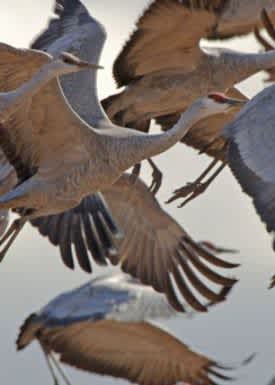Heritage Fund Helps Arizona’s Sandhill Cranes and Communities Grow
OutdoorHub 01.11.12

Phoenix, AZ– From just over 4,000 in the late 1970s to over 34,000 today, more sandhill cranes are calling Arizona their winter home, in part thanks to the Heritage Fund. The Heritage Fund, which was created by a voter-initiative to use Arizona Lottery dollars to support wildlife conservation, has been used to help secure ideal habitat for the birds in southeastern Arizona.
“One reason for the increasing number of cranes in the Sulfur Springs Valley is the availability of prime wetland habitat that the birds require and that the Game and Fish Department has provided. Cranes that used to fly south to Mexico now stop in Arizona because of those habitats,” said Mike Rabe, a migratory bird biologist with the Arizona Game and Fish Department.
The impressive increase in sandhill cranes means good news for wildlife enthusiasts. Seeing hundreds or even thousands of cranes take to the skies, feed in the fields or come in to land is a thrilling sight. Sandhill cranes are large birds; adults have about an 80-inch wingspan and can stand about 47 inches tall.
“The cranes will remain in southeastern Arizona until mid-late February, so there is still plenty of time to see and hear thousands of them,” said Joe Yarchin, watchable wildlife program manager for the department.
The Heritage Fund’s direct impact on wildlife conservation is compounded by the economic benefit that wildlife viewing has on communities across the state, especially in rural areas. The city of Willcox estimates that $60,000 to $80,000 comes into the local economy from hotel, gas, restaurant, and other related purchases just during Wings over Willcox, a four-day bird viewing event.
Two of the department’s wildlife areas – the Willcox Playa Wildlife Area near Willcox and the Whitewater Draw Wildlife Area near Douglas – offer visitors good viewing facilities, including bathrooms.
Sandhill crane viewing tips
- The best viewing time is at first and last light when the cranes head out to feed, although it is possible to see them throughout the day during winter (until mid-February).
- Listen for the birds: They are very vocal and can often be heard before they are seen.
- Don’t forget your binoculars, spotting scopes, cameras and bird field guides.
For more information on wildlife viewing opportunities in the state, visit www.azgfd.gov/wildlife.

